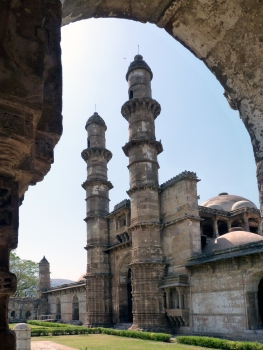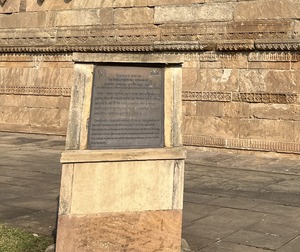Champaner-Pavagadh

The Champaner-Pavagadh Archaeological Park comprises an early Islamic, pre-Mughal city, whose architecture shows the transition between the Hindu and Muslim traditions.
This largely unexcavated city, built in the 16th century, was the short-lived capital of Gujarat. Spread across 12 locations at the bottom of and against a hill, fortifications, water installations, and different standing structures, remain. Among them is the Great Mosque, a model for later mosque architecture in India. The Pavagadh Hill itself is still a place of pilgrimage for Hindus who visit the earlier temple of Kalika Mata at its top.
Community Perspective: It's a messy site: Solivagant explains how this all happened and Zoë wonders about the slums inside the archaeological site. Els recently visited the top of the hill by cable car and found out that pre-booking online avoids the queues which are usually huge here.

Map of Champaner-Pavagadh
Community Reviews
Els Slots

As the name 'Champaner-Pavagadh' suggests, this site comprises two (contiguous) parts: Champaner (the remains of an Islamic pre-Mughal city) and Pavagadh (a hill with an important Hindu pilgrimage site). They are linked through their prime setting, the hill providing the water the city needed. As it was still relatively early in my 2024 India journey, I deep-dived into it via a day trip on public transport from Vadodara (better known locally under its old name Baroda).
The bus ride to Pavagadh takes about an hour and costs 40~60rs. Buses frequently leave from bays 15-18 at the central bus station; signage is only in Gujarati but just follow the colourful pilgrims on board. From Pavagadh bus station you have to walk about 500m to the right around the walls of the citadel, to where you can see the Jami Masjid – there used to be an entrance right across the street from the bus station (still present in Maps.me), but it is closed off nowadays and looks overgrown.
So I started my exploration with the Jami Masjid, the main mosque and the highlight of the Champaner site. I arrived at the same time as a French tour group, and there were a few local visitors as well. I was immediately taken by the very delicate stone carvings. With their geometrical motifs, they reminded me a bit of the Chaukhandi Tombs in Pakistan. The mosque is walled, with fine gateways, and its design with two minarets against the hilly background is picture perfect. On the inside, the carvings are continued in the mihrabs and segregation walls.
For the other parts of the Primary zone of Champaner Archaeological Site, you have to enter the Citadel across the street. This is also where you encounter the infamous village; people have been living inside the walls for decades, housing is permanent and there are shops and businesses. It didn’t bother me too much actually, maybe because I saw worse last year in Pakistan (Rohtas Fort!). It is not as if they are camping on the grounds of the two precious mosques - these are well-protected and gated. Just consider it as separate locations instead of a continuous area as shown on the (very bad) official map.
At the end of the village lies the Shaher ki Masjid (top photo). The setting with the Pavagadh Hill in the background again is very pretty and its design with multiple domes in a row is similar to what you can see in Bagerhat. In and around the village and the mosques are other points of interest, such as a water tank and a “Custom House”. The smaller Kevda Masjid and Nagina Masjid come recommended in Tripadvisor reviews as well, they can be accessed by following a small road to the right of the Custom House. There are also Jain shrines, some of which have been vandalized earlier this year, and another 11 components towards the town of Halol.
I moved on however to the Hindu pilgrimage part of this WHS: the trek to Pavagadh Hill. Over 2 million people arrive here yearly, so you don’t have to worry about finding transport or something to eat or drink. The first step involves wriggling yourself into one of the Jeeps that provide the transport from the main road (next to the bus station) to the foot of Pavagadh Hill. I think I saw at least 100 of them continuously drive the 5km up the mountain. They pack no less than 20 people in one car! A ride costs 30rs.
At the foot of the hill, the joyful pilgrimage atmosphere already is present, with a lot of people wearing orange robes or shawls. Even the donkeys, the workhorses of this mountain, wear an orange streak in their manes.
To get to the top of the hill, where the Hindu temple is, you can walk another 5km (only steps) or take the cable car (a.k.a. “ropeway”). I was already warned how long the queues could be for the cable car, but OMG: I walked and walked around the foot of the mountain to just find the start of the queue. The waiting time must surely have been 2 hours or more. I wanted to give it a go for an hour or so, to see how far I would advance – but I was “rescued” by some men ahead of me. They pointed me to Gate 3, the entrance for people who booked their cable car tickets online – no queue at all. The guard at first wouldn’t let me in (as of course I didn’t know about the booking process and there wasn’t a reliable data connection at the hill either to quickly do it), but the men argued in my favour: Foreigner! Alone! So finally the guard relented and let me in, and I was able to buy a cable car ticket (150rs) at the regular ticket office. I consider this VIP treatment as payback for the foreigner pricing practiced at all Indian WHS!
Within 15 minutes I was at the top. Here you’ll find a pond where people take ritual baths, an older temple and several shrines. To get to the Kalika Mata Temple you need to climb even more steps, but I skipped this since I had to leave my (good) shoes behind among a pile of thousands! The temple has been heavily reconstructed in 2022 anyway and construction is going on to extend the ropeway so that it arrives all the way up there.
Overall, Pavagadh Hill did feel more like a place for a family outing (I’d guess about a third of all shops along the path sell toys) than an overly religious place. Walking back down, however, I witnessed how the pious tackle this hill: by bowing down and putting a dab of red powder on the stairs at every single step they climb!
Read more from Els Slots here.
Zoë Sheng
Chinese-Canadian - 24-Jan-19 -

If any site in India should be de-listed it is Champaner. Unlike Manas which I find has no more value left, this inscription makes a mockery of any kind of buffer zone and management plan requirements. There is definitely value here and I enjoyed what I saw, a massive fort area that covers the two prominent mosque, several tombs and city walls, a hill that I didn't visit because there was a festival and I think the driver wanted to avoid getting stuck in traffic for hours (or an excuse), definitely value. However, even 7 years on since the last review nothing has changed. It has been inscribed for 13 years now. The slums are still inside the archeological park, the trash keeps piling up and we get charged 600 rupees for two mosque entries. The best part of these are the carvings but you will admire it for 20 minutes max and it is not as spectacular as other carvings in India.
The good news is that the road from Vadodara only take 40 minutes now, and if you want another approach you could get off Godrah junction and find a ride from there. I took an Ola for 1,400 half day outstation trip, with the driver coming sightseeing himself. Interesting enough there was NO guide service touting at either mosque. I expected a lot more from this and scheduled half a day else I would have rushed to somewhere else for the afternoon but instead I spent more time in Ahmedabad.
I think a message should be sent by putting this site on the in-danger list to get the state party moving.
Solivagant

The count on this Web site under “most visited sites” for Champaner was a mere 2 visits before we added our 2 from this February 2011. That places Champaner as the least-visited Indian cultural site among our “community”. I wonder why? Even Els on her current epic RTW journey didn’t make the relatively short detour from Bhopal on an overnight train to Vadodara but went straight on to Delhi!
As its title indicates, the site consists of 2 main elements, albeit within a single boundary in the form of the “Champaner-Pavagadh Archaeological Park” extending to over 1300ha (c5sq miles). It contains remains of human occupation from the Stone Age but the main sights relate to Hindu religious and military remains on the hill of Pavagadh, which still operates as a Hindu/Jain pilgrimage destination, together with the remains of the city of Champaner situated below the hill. This was, for a brief period in the late 15th/early 16th centuries, the capital of a pre-Mughal Islamic kingdom in Gujarat. It is particularly important for the quality of the architecture – both in its own right and for its significance in the development of an Indo-Islamic style. The city became deserted after Humayun (he of the tomb in Delhi!!) defeated the Gujarat kingdom in 1536.
The Champaner part of the site is situated around 90 minutes by good road from Vadodara (“Baroda”). There is then a road part way up Pavagadh hill from where you can either walk to the top or take a cable-way – we had a car, but a shuttle service of local taxis connects the 2. From what I gathered, many Western tourists don’t bother with Pavagadh Hill which, in architectural terms, doesn’t really offer anything special (we were the only Westerners I saw on the day we visited). However the view from the top and the “pilgrimage aspects” make it worthwhile doing so in my view unless you are very short of time. We had (unknowingly!) chosen to visit on a puja day and there were thousands of Hindus from all over Gujarat making the pilgrimage to the temple at the top of Pavagadh mountain.. This meant that we had to queue for around 45 minutes to get on the cable car and then for a similar time at the very top to pass through the temple (though not to come down luckily!). But it was all very good natured with a holiday atmosphere together with decorated holy cows and all the other sights of a Hindu pilgrimage. As we boarded the cable car we tried to forget that 7 people had died and others had been rescued by helicopter in an accident on the ropeway in Jan 2003!
Champaner was completely different – all the Indian visitors turned off at the bus/taxi stand up to Pavagarh and the site was almost deserted. There are city walls which are nothing special compared with those of many Indian forts. We concentrated on 2 of the Mosques (both pay-to-enter using the same ticket). The highlight is undoubtedly the Jama Masdid (photo - with Pavagarh Hill in the background). In 1484 the Gujarat Sultan Mahmud Bagada captured Pavagarh Fort from the local Hindu ruler of the Chauan dynasty which ran “Rajput” kingdoms across various parts of N India. He immediately set about building his new capital there using local architects and sculptors to interpet his “muslim requirements”. The result is certainly very fine and very “Indian”. The site in some ways reminded me of Bagherat in Bangladesh – another former capital where now only the Mosques provide an indicatiuon of what once has been there. At Champaner too there are various mosques together with pavilions etc scattered over a wide area. The Palace ruins are supposed to be on the way up to Pavargarh but we didn’t see them.
The ICOMOS evaluation of the site in 2004 was pretty negative and recommended “Deferral” both on the grounds of lack of a proper management plan and because OUV hadn’t been demonstrated (though it didn’t suggest that this couldn’t be done). So what did the WHC do – inscribed it immediately on criteria iii, iv, v and vi!! The Nomination file and the evaluation talk of the “living village” situated within Champaner ruins as if that were a plus point! Those who know India will understand what it really means – all human activities taking place and piles of rubbish etc lying around! Our guide was adamant that the inscribed area consisted solely of the monuments at Champaner but the on-site maps of the “Champaner-Pavagadh Archaeological Park” and the Nomination file make it quite clear that the mountain with its pilgrimage path, fort and summit temples is also included. But on the mountain there was absolutely no indication that the area was a UNESCO WHS – this was your typical Hindu pilgrimage site with all its myriad of traders and ad hoc developments. Inside the walls of Champaner, the first sign that one is at a WHS is the office at the Jama Masjid collecting the R250 entrance fee for foreigners and – yes, a sign commemorating the UNESCO inscription, albeit placed next a to a rubbish container shaped like a huge rabbit!
I have just been reading the UK T List panel report which indicated that any site wanting to consider getting onto the list must have Management Plans etc well in place before even considering applying for a T List spot. In India , and elsewhere in the developing world, a more pragmatic approach is often taken. In 2004 it would appear that UNESCO felt that it would have more leverage on India to produce the necessary plans if it actually inscribed the site. It therefore added the following request for “the Indian authorities to monitor the implementation of the Management Plan and submit a report by 1 February 2005”. In 2005 the request was repeated in a bit more detail with a 2007 deadline. In 2009 the WHC “Regrets that the State Party did not yet finalise and adopt the management plan, developed with full involvement of the established management authority, and built around a Statement of Outstanding Universal Value, to ensure the integrated conservation of the property”. So much for that strategy!!!
Unless you were particularly interested in the development of Indian/Muslim architecture or like us, were “collecting WHS”, Champaner doesn’t offer a great deal which is “special”. However, if Vadodara isn’t too much out of your way during your Indian trip, I would recommend taking it in. The late 19th Century Laxmi Vilas Palace in that city provides an amazing insight into the lives of the Maharajahs under the British Raj and some of the tribes around Champaner are worth visiting if your guide has an entrée. I am not entirely sure why India went for the site. Clearly Gujarat wanted a cultural nomination – but there are more significant ones elsewhere in the state. 2 are on the T List including possibly the most important one - the Indus valley city of Dholivara. But I suspect they require a lot more work to be done on them to bring them to a state suitable for inscription. Champaner clearly doesn’t meet the requirements even now!!
Community Rating
- : Frediehung Travelure RahulSharma
- : Stanislaw Warwas Velvetlapis
- : Vincent Cheung YAO WEI Yuri Samozvanov
- : Alexander Lehmann Bin Kurt Lauer Luke LOU Bernard Joseph Esposo Guerrero GerhardM
- : Wojciech Fedoruk Els Slots Ivan Rucek Philipp Peterer Xiquinho Silva Martina Rúčková
- : Szucs Tamas Solivagant Lichia Randi Thomsen Subhayan_svnit Svein Elias
- : Zoë Sheng Shandos Cleaver David Marton Mikko Lukasz Palczewski
- : Thomas van der Walt
Site Info
- Full Name
- Champaner-Pavagadh Archaeological Park
- Unesco ID
- 1101
- Country
- India
- Inscribed
- 2004
- Type
- Cultural
- Criteria
-
3 4 5 6
- Categories
- Archaeological site - South (East) Asian Religious structure - Hindu
- Link
- By ID
Site History
2004 Advisory Body overruled
ICOMOS advised Deferral (explain OUV, lack of mgt plan, comp analysis)
2004 Inscribed
Site Links
Unesco Website
Official Website
Related
In the News
Connections
The site has 28 connections
Art and Architecture
Constructions
History
Human Activity
Individual People
Religion and Belief
Science and Technology
Timeline
Trivia
Visiting conditions
WHS Names
WHS on Other Lists
Visitors
54 Community Members have visited.
The Plaque
 (photo by Els)
(photo by Els)